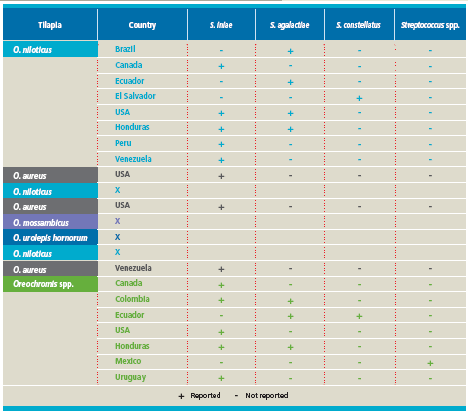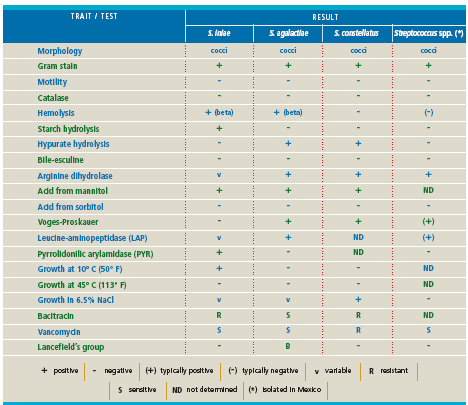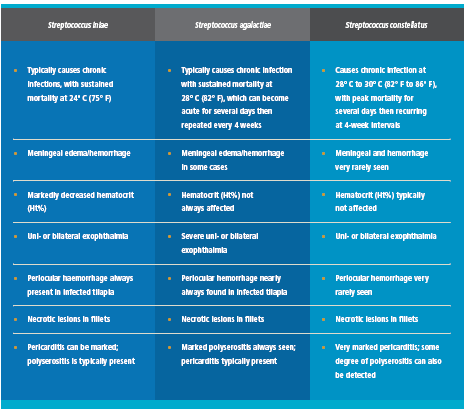In 1970 a 'new' disease was reported, which is not recognised as streptococcosis—that caused high mortality among cultivated Nile tilapia (Oreochromis niloticus) in Taiwan. Clinical signs included anorexia, a distended gut and extremely patent liver lesions.
In this particular case, a beta-hemolytic, Streptococcus pyogenes-like organism was isolated from the sick tilapia. It was believed that the bacterium could possibly have entered farms in manure used to fertilise the ponds.
Currently, streptococcosis is one of the most important bacterial infections affecting tilapia and has evolved from an “emerging pathology” into a true, fully identified, well-established entity. The disease has been reported worldwide, affecting over 45 different fish species grown in freshwater, estuarine and marine environments in Africa, the Americas, Asia, Australasia and Europe. On our continent, streptococcosis cases have been reported in cultivated tilapia in at least 12 countries in North, Central and South America and the Caribbean.
Clinical manifestations
Generally, streptococcosis-affected tilapia show a variety of clinical manifestations depending on the streptococcal species and the type or hybrid of tilapia involved. Typical clinical signs may include anorexia, lethargy, skin melanosis, hyperemia and petechial hemorrhages in the anal region and over the fins, hemorrhagic and necrotic lesions involving the skin and the muscle tissue, unilateral or bilateral exophthalmia with or without periocular hemorrhages, and corneal opacity.
A characteristic sign is the presence of erratic, disoriented swimming movements, mainly in moribund fish, which has led to the term “mad tilapia disease.” The abnormal swimming behavior is caused by meningoencephalitis, resulting from streptococcal invasion and infection of the brain and meninges.
Exophthalmia is generally associated with the early stages of the disease, with retrobulbar congestion and edema accompanied by inflammation and hyperemia, necrosis of the choroid coat and the optical nerve, resulting in expulsion of necrotised material through the ulcerated cornea. Corneal opacity or even corneal loss can also be found.
At autopsy, the spleen is typically enlarged. Both the liver and kidney are pale and mottled with numerous areas of focal necrosis. Pericarditis and polyserositis are frequently observed. The abdominal cavity may be distended and may contain a serous, bloody exudate. The branchial blood vessels are typically hyperemic and infiltrated by macrophages, in which case the gill filaments can show mass hemorrhage and undertake a necrotic process affecting broad branchial areas, causing a bad smell and resulting in increased mortality. The intestinal tract can also be hyperemic and the mucosa can continuously slough off.
Streptococcus species types
Infected tilapia undergo septicemia. Giemsa-stained blood smears may show macrophages engorged with streptococci. In cases caused by Streptococcus agalactiae, Streptococcus constellatus or Streptococcus iniae, bacterial pairs or chains can be adhered to the surface of red blood cells. Chronic tilapia streptococcosis cases are typically associated with granulomas.
Streptococcus spp. isolates obtained from sick tilapia in the Americas have been identified as S. agalactiae and S. iniae, even though some other isolates have been reported as S. constellatus and Streptococcus spp. (Table 1). Major phenotypic characteristics of these Streptococcus species are shown in Table 2. The following are among the most important traits that can be used to differentiate species:
- S. agalactiae does not hydrolyze starch and belongs to Lancefield's Group B (GBS).
- S. iniae hydrolyzes starch and does not belong to any of Lancefield's groups.
- S. constellatus and Streptococcus spp. (isolated from sick tilapia) do not hydrolyze starch and do not belong to any of Lancefield's groups.
It is important to mention that S. iniae can grow at 10º C (50º F). On the other hand, S. agalactiae and S. constellatus do not grow at this temperature. As a matter of fact, Dr Conroy confirms that the infection of tilapia with S. iniae is more common when water temperatures range from 15º C to 24º C (59º F to 75.2º F), while S. agalactiae infections are more frequent at 24º C to 28º C (75.2º F to 82.4º F) and S. constellatus infections seem to prevail at 28º C to 30º C (82.4º F to 86º F).
In some countries, S. iniae is the species most often found, while in other countries S. agalactiae prevails. Nevertheless, both streptococcal species can exist in several countries, which explains the trend to find a S. iniae epizootic followed by another outbreak caused by S. agalactiae, and vice versa. This seems to be influenced by the prevailing temperature of water in culture ponds. The fact that S. agalactiae, S. constellatus and S. iniae include varieties with the ability to grow in 6.5 per cent sodium chloride raises the possibility that these bacterial species can be of pathological importance in tilapia operations using estuarine, brackish or marine waters.

It can be generally said that S. agalactiae prevails among Latin American countries, as evidenced by both the literature and the author’s personal observations.
In the experience of the author, particularly in Latin America, clinical signs and pathological manifestations of sick tilapia can vary depending on the streptococcal species causing the infection, as shown in Table 3.
One extremely relevant aspect of tilapia streptococcosis is the severe pathological changes affecting muscular tissue, rendering fillets inappropriate for trade.


In 1994, is was found that O. niloticus was susceptible to streptococcal infection after injuring the skin surface. The highest mortality was obtained when the fish were kept in 30º/oo salinity water at 25º C (77º F), or 15º/oo salinity at 30º C (86º F), indicating that tilapia susceptibility to streptococcosis increases as both salinity and water temperature increase. In 1993, researchers found that fish surviving a streptococcosis outbreak remain a permanent infection source in situ. Once the disease enters a tilapia farm/production centre, it becomes extremely difficult or impossible to eradicate.
It has been shown that managing high stocking densities or keeping high fish biomass in the cultivation ponds is enough to trigger the expression of streptococcosis, resulting in high mortality rates within a few weeks. Likewise, after an early streptococcosis outbreak (that isn’t always recognised by the producer)—and as a result of high stress levels caused by high stocking density, high biomass, water quality deterioration, capture and the transfer process itself—the fish can weaken and succumb to the peak expression of this infectious process, resulting in sustained, high, post-transfer mortality rates for up to 3 weeks in a row; this may occur throughout any of the post-transfer cultivation phases. The speed with which clinical signs and then mortality appear depends on water temperature, oxygen concentration, biomass and the streptococcal species affecting the farm/ production center.
Major streptococcosis prevention/control methods in tilapia operations include implementing optimum management procedures throughout each production stage. Dead and moribund tilapia must be removed from the ponds and then destroyed by incineration. Both water physico-chemical (particularly oxygen concentrations and temperature) and biological parameters must be monitored constantly and maintained within the range of values recommended for the corresponding tilapia species/hybrid.



